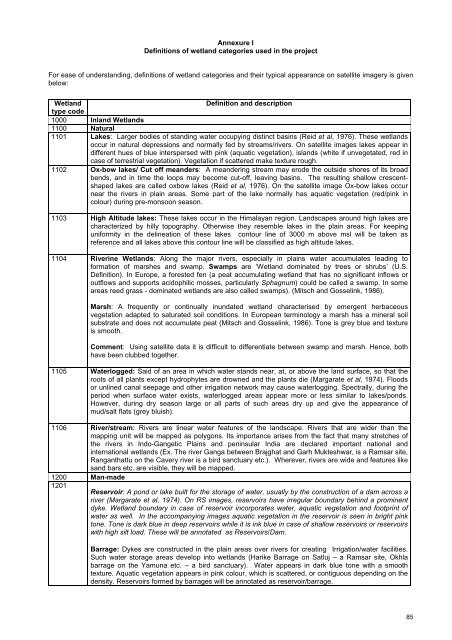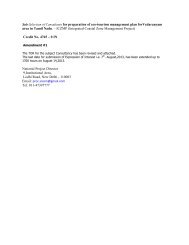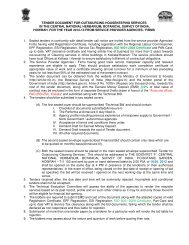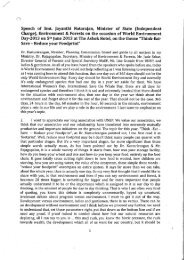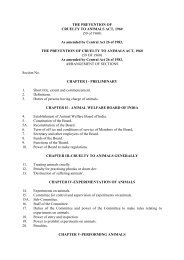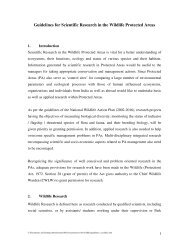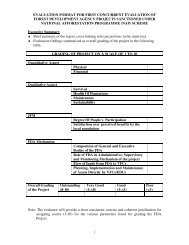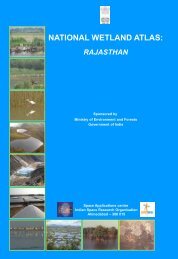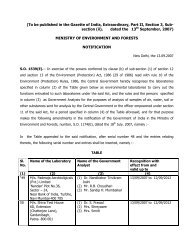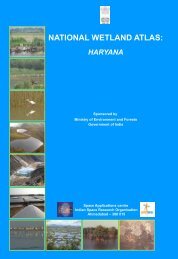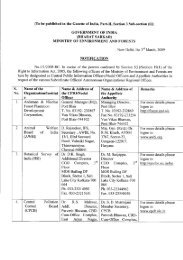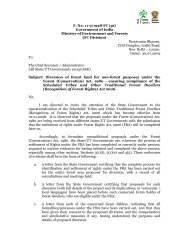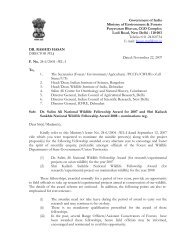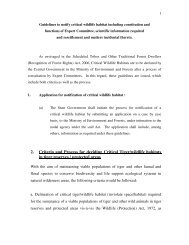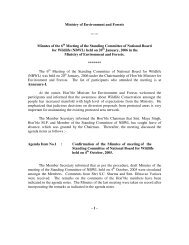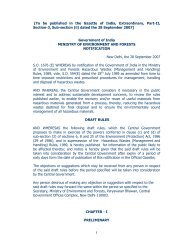Meghalaya - Ministry of Environment and Forests
Meghalaya - Ministry of Environment and Forests
Meghalaya - Ministry of Environment and Forests
- No tags were found...
You also want an ePaper? Increase the reach of your titles
YUMPU automatically turns print PDFs into web optimized ePapers that Google loves.
Annexure IDefinitions <strong>of</strong> wetl<strong>and</strong> categories used in the projectFor ease <strong>of</strong> underst<strong>and</strong>ing, definitions <strong>of</strong> wetl<strong>and</strong> categories <strong>and</strong> their typical appearance on satellite imagery is givenbelow:Wetl<strong>and</strong>Definition <strong>and</strong> descriptiontype code1000 Inl<strong>and</strong> Wetl<strong>and</strong>s1100 Natural1101 Lakes: Larger bodies <strong>of</strong> st<strong>and</strong>ing water occupying distinct basins (Reid et al, 1976). These wetl<strong>and</strong>soccur in natural depressions <strong>and</strong> normally fed by streams/rivers. On satellite images lakes appear indifferent hues <strong>of</strong> blue interspersed with pink (aquatic vegetation), isl<strong>and</strong>s (white if unvegetated, red incase <strong>of</strong> terrestrial vegetation). Vegetation if scattered make texture rough.1102 Ox-bow lakes/ Cut <strong>of</strong>f me<strong>and</strong>ers: A me<strong>and</strong>ering stream may erode the outside shores <strong>of</strong> its broadbends, <strong>and</strong> in time the loops may become cut-<strong>of</strong>f, leaving basins. The resulting shallow crescentshapedlakes are called oxbow lakes (Reid et al, 1976). On the satellite image Ox-bow lakes occurnear the rivers in plain areas. Some part <strong>of</strong> the lake normally has aquatic vegetation (red/pink incolour) during pre-monsoon season.1103 High Altitude lakes: These lakes occur in the Himalayan region. L<strong>and</strong>scapes around high lakes arecharacterized by hilly topography. Otherwise they resemble lakes in the plain areas. For keepinguniformity in the delineation <strong>of</strong> these lakes contour line <strong>of</strong> 3000 m above msl will be taken asreference <strong>and</strong> all lakes above this contour line will be classified as high altitude lakes.1104 Riverine Wetl<strong>and</strong>s: Along the major rivers, especially in plains water accumulates leading t<strong>of</strong>ormation <strong>of</strong> marshes <strong>and</strong> swamp. Swamps are ‘Wetl<strong>and</strong> dominated by trees or shrubs’ (U.S.Definition). In Europe, a forested fen (a peat accumulating wetl<strong>and</strong> that has no significant inflows oroutflows <strong>and</strong> supports acidophilic mosses, particularly Sphagnum) could be called a swamp. In someareas reed grass - dominated wetl<strong>and</strong>s are also called swamps). (Mitsch <strong>and</strong> Gosselink, 1986).Marsh: A frequently or continually inundated wetl<strong>and</strong> characterised by emergent herbaceousvegetation adapted to saturated soil conditions. In European terminology a marsh has a mineral soilsubstrate <strong>and</strong> does not accumulate peat (Mitsch <strong>and</strong> Gosselink, 1986). Tone is grey blue <strong>and</strong> textureis smooth.Comment: Using satellite data it is difficult to differentiate between swamp <strong>and</strong> marsh. Hence, bothhave been clubbed together.1105 Waterlogged: Said <strong>of</strong> an area in which water st<strong>and</strong>s near, at, or above the l<strong>and</strong> surface, so that theroots <strong>of</strong> all plants except hydrophytes are drowned <strong>and</strong> the plants die (Margarate et al, 1974). Floodsor unlined canal seepage <strong>and</strong> other irrigation network may cause waterlogging. Spectrally, during theperiod when surface water exists, waterlogged areas appear more or less similar to lakes/ponds.However, during dry season large or all parts <strong>of</strong> such areas dry up <strong>and</strong> give the appearance <strong>of</strong>mud/salt flats (grey bluish).1106 River/stream: Rivers are linear water features <strong>of</strong> the l<strong>and</strong>scape. Rivers that are wider than themapping unit will be mapped as polygons. Its importance arises from the fact that many stretches <strong>of</strong>the rivers in Indo-Gangetic Plains <strong>and</strong> peninsular India are declared important national <strong>and</strong>international wetl<strong>and</strong>s (Ex. The river Ganga between Brajghat <strong>and</strong> Garh Mukteshwar, is a Ramsar site,Ranganthattu on the Cavery river is a bird sanctuary etc.). Wherever, rivers are wide <strong>and</strong> features likes<strong>and</strong> bars etc. are visible, they will be mapped.1200 Man-made1201Reservoir: A pond or lake built for the storage <strong>of</strong> water, usually by the construction <strong>of</strong> a dam across ariver (Margarate et al, 1974). On RS images, reservoirs have irregular boundary behind a prominentdyke. Wetl<strong>and</strong> boundary in case <strong>of</strong> reservoir incorporates water, aquatic vegetation <strong>and</strong> footprint <strong>of</strong>water as well. In the accompanying images aquatic vegetation in the reservoir is seen in bright pinktone. Tone is dark blue in deep reservoirs while it is ink blue in case <strong>of</strong> shallow reservoirs or reservoirswith high silt load. These will be annotated as Reservoirs/Dam.Barrage: Dykes are constructed in the plain areas over rivers for creating Irrigation/water facilities.Such water storage areas develop into wetl<strong>and</strong>s (Harike Barrage on Satluj – a Ramsar site, Okhlabarrage on the Yamuna etc. – a bird sanctuary). Water appears in dark blue tone with a smoothtexture. Aquatic vegetation appears in pink colour, which is scattered, or contiguous depending on thedensity. Reservoirs formed by barrages will be annotated as reservoir/barrage.85


